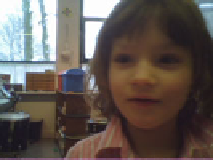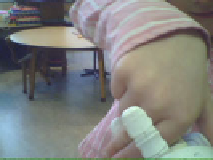Information Technology Reference
In-Depth Information
filmed different test persons performing the handshaking interaction and con-
cluded that most of them would approach the partner, have a brief glance to the
meeting points of the hands, and perform the handshaking.
To capture a realistic human movement, he used the following sequence of
actions: (1)The usage of markers: markers were used to stick on actors arm; (2);
The usage of coordinate: a 3-dimensional coordinate was been put to calculate
the directions of each movement; (3) The usage of stick model: the stick model
would also be used in this recording process, all human bodies of actors ware
replaced by stick model; (4) The observation: the observation was taken by both
video camera and monitor. The observation was mainly aimed to observe some
other small changes during the hand shaking process, such as head movements,
eye movements and body movements.
Based on this preparatory work, the handshake behavior was created within
an hour. The handshake behavior contains 8 serial movem commands the third
and fourth are as follows:
movem(RShoulderPitch, 33, 200, 33, 800, 32, 200,
RElbowRoll,
38, 200, 35, 600, 36, 200, 35, 200,
HeadPitch,
20, 800,
HeadYaw,
-25, 800)
&
movem(RShoulderPitch, 33, 200, 33, 600, 30, 400,
RElbowRoll,
36, 200, 36, 200, 35, 200, 32, 400, 33, 200,
RHand,
57, 400, 20, 600,
HeadPitch,
15, 600,
0, 600,
HeadYaw,
-20, 600, -10, 600)
When completed, a user test of handshaking behavior was made in Maria el-
ementary school in Helmond, The Netherlands. The children could naturally
understand and perform the handshaking behavior without further guidance.
Figure 4 shows some images from the user testing. Figure 4a shows the view
from a side camera. Figure 4b and 4c depicts 2 snapshot views of the robot
during handshaking interaction.
a)
b) c)
Fig. 4.
a) Child shaking hand with robot. b-c) View from robot perspective.



Search WWH ::

Custom Search